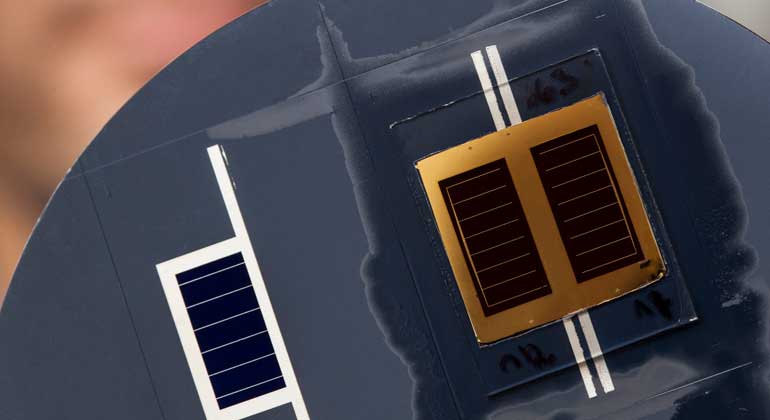New Records for the solar cell of tommorrow
The U.S. Department of Energy’s National Renewable Energy Laboratory (NREL), CSEM and EPFL have taken an important symbolic step forward.
When you choose to go solar, you have to go for the optimum trade-off between conversion efficiency and cost! Efficiency rates of more than 35% have been reached in the laboratory, but with cells that only use expensive materials. The existing photovoltaics (PV) market is rather dominated by cost-effective modules made of single-junction silicon solar cells, with efficiencies ranging between 17% and 22%. Just like many research centers and industrial players, NREL, CSEM and EPFL are working with what are known as ‘multi-junction’ cells, a technology that combines silicon with a cell that absorbs blue light from the sun more efficiently.
The transition from a silicon single-junction cell to a silicon-based multi-junction solar cell has the potential to push efficiencies past 30% while still benefiting from the cost-effective manufacturing expertise in making silicon solar cells. NREL and Swiss scientists have devoted themselves to producing such solar cells with over 30% efficiency. In January 2016, this researcher’s team was able to reach 29.8% efficiency, setting their first joint world record.
NREL and CSEM demonstrate the potential for this new generation of solar cells
By working together again, the scientists team from CSEM, a Swiss research and technology center, EPFL, and NREL, have beaten their own record and cemented their positions as the top experts in this technology: an efficiency of 32.8 % was achieved for a dual-junction solar cell made by combining NREL GaAs top cell to CSEM silicon heterojunction bottom cell, and an efficiency of 35.9 % was attained for a triple-junction solar cell by combining NREL GaInP/GaAs top cell to CSEM silicon heterojunction bottom cell. Stephanie Essig of EPFL is lead author of the newly research paper published in the recent issue of Nature Energy, that details the steps taken to improve the efficiency of the multi-junction cell and the steps required for decreasing their manufacturing costs. “This achievement is significant because it shows, for the first time, that silicon-based tandem cells can provide efficiencies competing with more expensive multi-junction cells consisting entirely of III-V materials,” said Adele Tamboli, a senior researcher at NREL. “It opens the door to develop entirely new multi-junction solar cell materials and architectures.”
Making solar energy more accessible
“These records show that combining crystalline silicon and other materials is the way forward if we are to improve solar power’s cost/efficiency ratio,” said Christophe Ballif, Director of CSEM’s PV-center and EPFL Photovoltaics laboratory. “It affirms that silicon heterojunction solar cells, when integrated into the structure that we’ve developed, can generate multi-junction cell conversion efficiencies over 32%” said Matthieu Despeisse, manager of crystalline silicon solar cells activities at CSEM.
CSEM is working actively on such silicon-based multi-junction solar cells and is also testing new materials to be used as top cell in order to optimize solar power’s cost/efficiency ratio. For example, it is studying the potential use of perovskite as part of the European CHEOPS Project.








